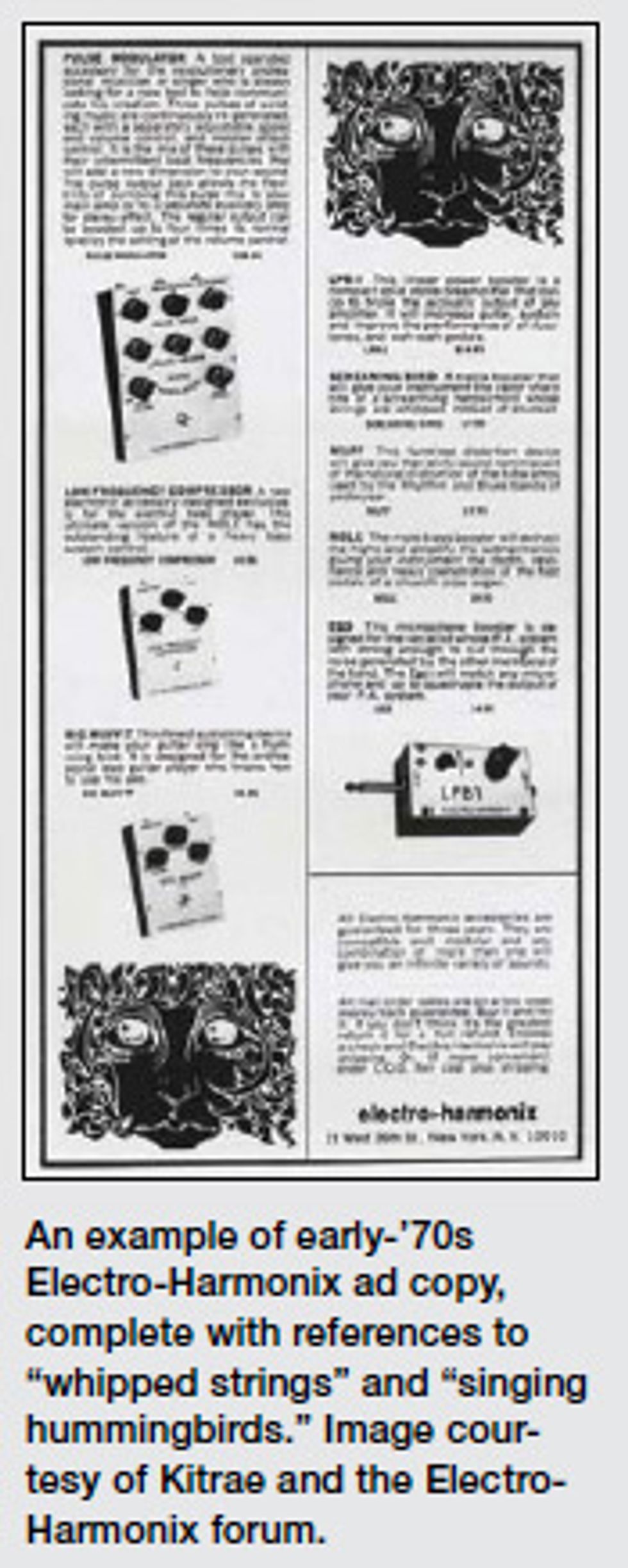I’d like to open this column
by saying it’s an honor to
have been chosen to write it.
When I was first offered the
gig, my initial reaction was,
“Why me?” With so many
better-known companies and
talented designers out there, I
was surprised that PG editors
considered me worthy of writing
a column about pedals.
While I have some knowledge
of effect design, I’m not an
engineer—I’m not even a guitarist
(although I have been
known to “slap da bass”)!
When I asked a PG editor about this, he said my “experience marketing different effect brands from around the globe gives me a unique perspective on the effects industry as a whole.” I think this answer confused me even more, but it also got me thinking: Do I have a unique perspective? And if so, what is it? How did it lead me to the various pedal lines I’ve worked with over the years? Is there a common thread running between all the brands we’ve handled, and if so, what is it? Did I see something other people didn’t, or was it just dumb luck?
One thing I will say is that sometimes not being an engineer has its benefits. In my experience, designers can sometimes take a myopic view of their creation and overlook small aspects that could take the design from good to great. I do have a tendency to look at the whole picture (or lack thereof ), and this has certainly worked to my advantage in the past.
At this point, it might help to offer a bit of background on how I got into this business. I owe my fascination with effects almost entirely to one person—Mike Matthews from Electro-Harmonix. When I was a kid in the late ’70s, EHX was at the height of their first round of success, which was due in no small part to Matthews’ ability to write incredibly captivating— often mesmerizing—ad copy about his pedals.
A pedal that can make your amp 10 times louder? Whoa! How about one that makes your guitar talk? Or sound like “a screeching harpsichord whose strings are whipped instead of plucked”? These were just a few of the amazing benefits that vintage EHX pedals could bestow on the lucky user—at least according to their catalog.
Keep in mind, there was no streaming video or other ways to preview pedals back then (hell, there weren’t even websites). When it came to creating demand for a product, ad copy was everything—and the only thing.
The EHX catalog was more mysterious and intriguing than those “grow your own Sea Monkey” ads in the back of comic books. To a 13-year-old kid just starting to play, it was better than porn. If you’ve never seen a vintage EHX catalog, I strongly urge you to hunt one down on the internet and give it a read. You’ll witness a modern day P.T. Barnum in action.
Years later, I was fortunate enough to work for the resurrected EHX and help with the launch of reissues like the Memory Man and new products like the Q-Tron. I learned a lot working for Mike Matthews, but probably the most important thing I took away from the experience was that a product needs a good story to stand out from the competition.
Great sounds, the right price point, and bulletproof construction aside, it’s a great story that really grabs people’s attention. Once they’re hooked by the story, they can be reeled in by a product’s features and benefits. Many of PG’s more conservative readers might balk at this assessment. For them, pedals are tools—not toys. However, keep in mind that even that mindset is just another story that appeals to a particular type of player.
Would Fulltone have been as successful if there weren’t photos of Mike Fuller’s Porsches, Harleys, and vintage amps plastered on their website? Fulltone was selling the story of success—their product just had the added benefit of being able to help deliver it.
Oh yeah, so back to me and my perspective. Looking back now, it’s pretty easy to see the unique feature or “story” that each of our brands carries. In my view, each of these attributes played a key role in helping us bring these brands to market without a major financial investment:
Guyatone Micro Effects. The totally cute, ultra-compact size and candy colors were what initially caught my eye. In 1998, this had never been done before (but it was soon copied by a much larger company).
Bixonic Expandora. The round “tuna fish can” chassis was a unique statement, and an endorsement from one Billy Gibbons of ZZ Top certainly didn’t hurt.
Maxon. The guys that designed and manufactured Ibanez pedals from 1974- 98? Come on, this one’s a no-brainer.
As you can see, there’s no common thread between the lines that we’ve represented, except for the fact that each of them had a unique quality or “story” we could use to catch people’s attention. From there, the product itself did most of the work.
So, I guess my perspective is this: I like to view the “big picture” and envision where and how products can fit into the market. I’m able to recognize a good story and this ability— coupled with a fair degree of serendipity and lots of hard work— has allowed me to be surrounded by guitar effects for the past 12+ years and continue to earn a living doing what I love.
In future columns, I’ll expand on this idea and apply it to other brands and products, as well as trends in the effects market. Until then, thanks for reading. If you have any topics you’d like to see covered, please drop me a line at kevin@godlyke. com. Rock on!
 Kevin Bolembach
is the President and
founder of Godlyke, Inc.
- the U.S.distributor for
many well-know boutique
effect brands
Including Maxon,
Guyatone, EMMA and Providence.
Kevin Bolembach
is the President and
founder of Godlyke, Inc.
- the U.S.distributor for
many well-know boutique
effect brands
Including Maxon,
Guyatone, EMMA and Providence.
When I asked a PG editor about this, he said my “experience marketing different effect brands from around the globe gives me a unique perspective on the effects industry as a whole.” I think this answer confused me even more, but it also got me thinking: Do I have a unique perspective? And if so, what is it? How did it lead me to the various pedal lines I’ve worked with over the years? Is there a common thread running between all the brands we’ve handled, and if so, what is it? Did I see something other people didn’t, or was it just dumb luck?
One thing I will say is that sometimes not being an engineer has its benefits. In my experience, designers can sometimes take a myopic view of their creation and overlook small aspects that could take the design from good to great. I do have a tendency to look at the whole picture (or lack thereof ), and this has certainly worked to my advantage in the past.
At this point, it might help to offer a bit of background on how I got into this business. I owe my fascination with effects almost entirely to one person—Mike Matthews from Electro-Harmonix. When I was a kid in the late ’70s, EHX was at the height of their first round of success, which was due in no small part to Matthews’ ability to write incredibly captivating— often mesmerizing—ad copy about his pedals.
A pedal that can make your amp 10 times louder? Whoa! How about one that makes your guitar talk? Or sound like “a screeching harpsichord whose strings are whipped instead of plucked”? These were just a few of the amazing benefits that vintage EHX pedals could bestow on the lucky user—at least according to their catalog.
Keep in mind, there was no streaming video or other ways to preview pedals back then (hell, there weren’t even websites). When it came to creating demand for a product, ad copy was everything—and the only thing.
The EHX catalog was more mysterious and intriguing than those “grow your own Sea Monkey” ads in the back of comic books. To a 13-year-old kid just starting to play, it was better than porn. If you’ve never seen a vintage EHX catalog, I strongly urge you to hunt one down on the internet and give it a read. You’ll witness a modern day P.T. Barnum in action.
Years later, I was fortunate enough to work for the resurrected EHX and help with the launch of reissues like the Memory Man and new products like the Q-Tron. I learned a lot working for Mike Matthews, but probably the most important thing I took away from the experience was that a product needs a good story to stand out from the competition.
Great sounds, the right price point, and bulletproof construction aside, it’s a great story that really grabs people’s attention. Once they’re hooked by the story, they can be reeled in by a product’s features and benefits. Many of PG’s more conservative readers might balk at this assessment. For them, pedals are tools—not toys. However, keep in mind that even that mindset is just another story that appeals to a particular type of player.
Would Fulltone have been as successful if there weren’t photos of Mike Fuller’s Porsches, Harleys, and vintage amps plastered on their website? Fulltone was selling the story of success—their product just had the added benefit of being able to help deliver it.
Oh yeah, so back to me and my perspective. Looking back now, it’s pretty easy to see the unique feature or “story” that each of our brands carries. In my view, each of these attributes played a key role in helping us bring these brands to market without a major financial investment:
Guyatone Micro Effects. The totally cute, ultra-compact size and candy colors were what initially caught my eye. In 1998, this had never been done before (but it was soon copied by a much larger company).
Bixonic Expandora. The round “tuna fish can” chassis was a unique statement, and an endorsement from one Billy Gibbons of ZZ Top certainly didn’t hurt.
Maxon. The guys that designed and manufactured Ibanez pedals from 1974- 98? Come on, this one’s a no-brainer.
As you can see, there’s no common thread between the lines that we’ve represented, except for the fact that each of them had a unique quality or “story” we could use to catch people’s attention. From there, the product itself did most of the work.
So, I guess my perspective is this: I like to view the “big picture” and envision where and how products can fit into the market. I’m able to recognize a good story and this ability— coupled with a fair degree of serendipity and lots of hard work— has allowed me to be surrounded by guitar effects for the past 12+ years and continue to earn a living doing what I love.
In future columns, I’ll expand on this idea and apply it to other brands and products, as well as trends in the effects market. Until then, thanks for reading. If you have any topics you’d like to see covered, please drop me a line at kevin@godlyke. com. Rock on!
 Kevin Bolembach
is the President and
founder of Godlyke, Inc.
- the U.S.distributor for
many well-know boutique
effect brands
Including Maxon,
Guyatone, EMMA and Providence.
Kevin Bolembach
is the President and
founder of Godlyke, Inc.
- the U.S.distributor for
many well-know boutique
effect brands
Including Maxon,
Guyatone, EMMA and Providence.






![Rig Rundown: Russian Circles’ Mike Sullivan [2025]](https://www.premierguitar.com/media-library/youtube.jpg?id=62303631&width=1245&height=700&quality=70&coordinates=0%2C0%2C0%2C0)

















